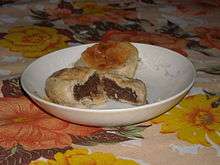Bakpia
 | |
| Alternative names | Hopia |
|---|---|
| Type | Pastry, sweet roll |
| Place of origin | China |
| Region or state | Maritime Southeast Asia |
|
| |
Bakpia (Chinese: 肉餅; Pe̍h-ōe-jī: bah-piáⁿ; literally: "meat pastry") or hopia (Chinese: 好餅; Pe̍h-ōe-jī: hó-piáⁿ; literally: "good pastry") is a popular Indonesian and Philippine bean-filled moon cake-like pastries originally introduced by Fujianese immigrants in urban centres of both countries around the turn of the twentieth century. It is a widely available inexpensive treat and a favoured gift for families, friends and relatives.
In Indonesia, it is also widely known as Bakpia Pathok, named after a suburb of Yogyakarta which specialises in the pastry.[1] These sweet rolls are similar to bigger Indonesian pia, the only difference being the size.
Types of dough
Flaky type
The flaky type of bakpia uses Chinese puff pastry. Clear examples of this can be seen in China (especially Macau), Taiwan and countries with established Chinese diaspora communities such as Trinidad & Tobago and Guyana making this type the authentic Chinese hopia. In addition, there is more skill involved in making this type of hopia crust.
Cake-dough type
The cake-dough type uses a soft cookie-dough similar in texture & taste to the wrapper-dough for fig newtons. This type is very similar to Japanese bean cakes, which grants it the name hopyang Hapon (Japanese bean cake in Filipino).
Fillings
Below are the four traditional and most popular bakpia fillings, though recently other fillings have been created such as cappuccino, cheese, chocolate, custard, durian, mango, pineapple and screwpine (pandan).[2][3]
Mung bean

The most popular flaky bakpia both in Indonesia and the Philippines is mung bean bakpia (Indonesian: bakpia kacang hijau; Tagalog and Visayan: hopyang munggo),[4] sometimes referred to as hopyang matamís ("sweet hopia" in Tagalog). As its name implies, it is filled with sweet split mung bean paste.
Pork
Hopyang baboy (Tagalog and Visayan for "pork hopia") is filled with a savoury bread-crumb paste studded with candied wintermelon, flavoured with scallion and enriched with candied pork back fat, hence its name. This type of hopia is also sometimes referred to as hopyang maalat (Tagalog for "salty hopia").
Purple yam (Dioscorea alata)
Though purple yam (Malaysian and Indonesian: uwi; Visayan and Tagalog: ube/ubi) delicacies were traditionally served mainly during the Christmas season, its unique, vivid violet colour and sweet taste has caused hopyang ube (Visayan and Tagalog for purple-yam hopis) to become a clear and huge favourite all year-round. The hopia variant is also reminiscent of halayáng ube (ube jam), which is a staple in Philippine celebrations.
While included among the traditional hopia variants, purple-yam hopis was created in the 1980s by Gerry Chua of Eng Bee Tin Chinese Deli in the Binondo district of Manila.[5]
Azuki bean
Azuki-bean hopia are small, round cake-dough type hopia usually filled with sweet azuki bean paste, similar in appearance to small mooncakes served during the Chinese Mid-Autumn Festival. These are also often formed into cubes and cooked on a griddle one side at a time instead of being baked in an oven. Due to its similarities in filling, crust texture, and style to the Japanese kuri manjū, it earned the popular moniker hopyang Hapón (Filipino for "Japanese hopia").
References
| Wikimedia Commons has media related to Bakpia. |
- ↑ A Budi Kurniawan, Erwin E Prasetya (3 January 2014). "Bakpia, Buah Tangan Toleransi dan Akulturasi". Kompas.com (in Indonesian). Retrieved 13 January 2015.
- ↑ http://hidayatbahri.wordpress.com/ Dayat Story Blogs (Indonesian)
- ↑ "New Innovation: HOPIA CUSTARD CLASSIC and UBE". YouTube. 9 June 2012. Retrieved 12 February 2015.
- ↑ http://www.bakpiasongjie01.com Bakpia Pathok Song Jie 01
- ↑ "Eng Bee Tin". engbeetin.com. Archived from the original on 12 February 2015. Retrieved 12 February 2015.